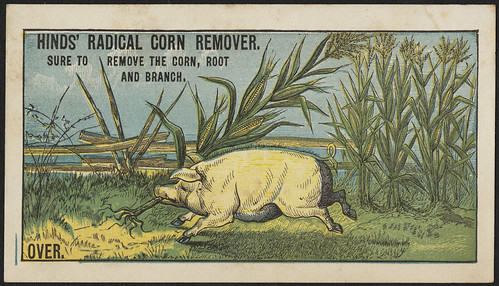
Thomas Crapper, born on this day in 1836, is often credited with the invention of the flush toilet. However, according to Nick Valéry at More Intelligent Life, that honor officially belongs to Alexander Cummings, a watchmaker “who was granted the first patent for a flush toilet in 1775,” more than 60 years before Crapper was born.
While, as Snopes says, Crapper “didn’t have much to do” with the development of flush toilets (and the nickname crapper may come from his name emblazoned on his plumbing products, or it may simply come from the word crap), he certainly popularized them, which is a good enough excuse for us to explore a brief history of toilet language.
Privy is a very old word for what we’d call the bathroom, with it earliest citation in the Oxford English Dictionary (OED) from 1225. The word privy comes from the Old French privé, “intimate friendly; a private place.”
No matter how friendly, privies were often outside, and so chamber pots were used instead. A chamber pot was sometimes referred to as a potty, which we now use to refer to a child’s “training” toilet or as a childish way of saying you gotta go.
By 1579, we had gained the euphemism little house, which referred to “a room or building used as a toilet,” says the OED, especially “one without plumbing or situated outside.” Outhouse, mainly used in American English, is from about 1819.
By the early 18th-century, sailors were using head to refer to the latrine, which was located in the bow, or head, of the ship. John came later, possibly around 1735, when in a Harvard University publication, the men’s room is referred to as cuzjohn, short for “cousin john.”
Why cousin? Perhaps because it’s a term of familiarity and intimacy. Why john? There’s some speculation that john comes from Sir John Harington, who designed a flush toilet for his godmother, Queen Elizabeth, although the Online Etymology Dictionary says john is simply an alteration of another toilet term, jakes. Why jakes? The OED suggests (unsatisfyingly) that jakes comes from the proper name.
Water closet, or W.C., is from 1736 while earth closet, a lavatory in which dirt or earth used to cover excrement, is from 1863. Slang for earth closet is dunny, which might come from the Australian convict cant term, dunnekin, or cesspit.
Some lavatory lexicon originated with different meanings, such as, well, lavatory. Originating in the 14th century, the word first meant “a vessel for washing,” says the OED. By 1656, it referred to a place for washing, and finally by the 20th century, the meaning we use today.
The bathroom began in 1780 as a place for bathing and became a polite way to refer to the lavatory in early 20th-century America, which apparently “confused British travelers,” so says the Online Etymology Dictionary.
Ladies’ room (1825) began as a shortening of ladies’ cloakroom while restroom (1856), says the OED, was a place for “rest and relaxation,” especially in a “public building or workplace.” It’s unclear when these terms came to mean lavatory although we’d venture a guess it was the early half the 20th century.
Women’s room is from 1918 while men’s room is slightly later, from 1929. The euphemisms little boys’ room and little girls’ room are from the 1930s. The OED’s earliest citation for little girls’ room is from John O’Hara’s novel, Butterfield 8:
The women’s toilet (as distinguished from the ladies’ room in a speakeasy, the johnny at school, the little girls’ room at a party in an apartment, and the wash-my-hands on a train) was clean enough.
There are a couple of theories about the origins of the British English loo, which is from about 1922. One is that it comes from a French term picked up by British soldiers during World War I, lieux d’aisances, which translates as “place of ease.” Another says it’s a pun on Waterloo, which is “based on water closet.” (For even more on loo, check out this great post from Anatoly Liberman.)
Throne arose around the same time as loo. The OED’s earliest citation of throne meaning toilet is from James Joyce’s Ulysses: “With beaded mitre and with crozier, stalled upon his throne, widower of a widowed see, with upstiffed omophorion, with clotted hinderparts.”
The dainty U.S. moniker powder room came about in the late 1920s. While it might seem logical that this sense would originate from the earlier British English meaning of a room where one would have one’s wigs powdered, a gap of 139 years and the Atlantic Ocean makes a direct connection seem doubtful.
Honeypot is 1940s military slang for a makeshift toilet. Another honey word for this not-so-sweet business is honey bucket, North American slang used especially in Canada and Alaska. Also used in Alaska is nushnik, which comes from the Russian nužnik, “latrine, toilet.”
Another U.S. regional term is biffy, which the American Heritage says is from the Upper Midwest but also, at least according to some of our pals on Twitter, used in parts of Ontario, Canada. Biffy might be an alteration of privy, or else, as word taster James Harbeck says, it could come from bivouac, a temporary encampment, by way of bivvy.
Netty, which is from North East England, might be short for the Italian gabbinetti, toilets, or, more likely, an alteration of “necessary.” A necessarium once referred to a privy in a monastery and is now is humorous way to refer to the toilet. Commode comes from the French word for “convenient,” while the far less elegant can might be short for piss-can.
Thunderbox, a portable commode, is presumably named for the sounds that might emanate from there. Khazi might come from the Italian casa, “house,” by way of the Cockney carsey or karzy. Cludgie, also kludgie, is Scots and might be a blend of closet and lodge. Finally, kybo, a Scouting term for an outhouse, is an acronym that stands for either Keep Your Bowels Open or Keep Your Bowels Operating.
Have any other lavatory language to share? Add them to this list!





